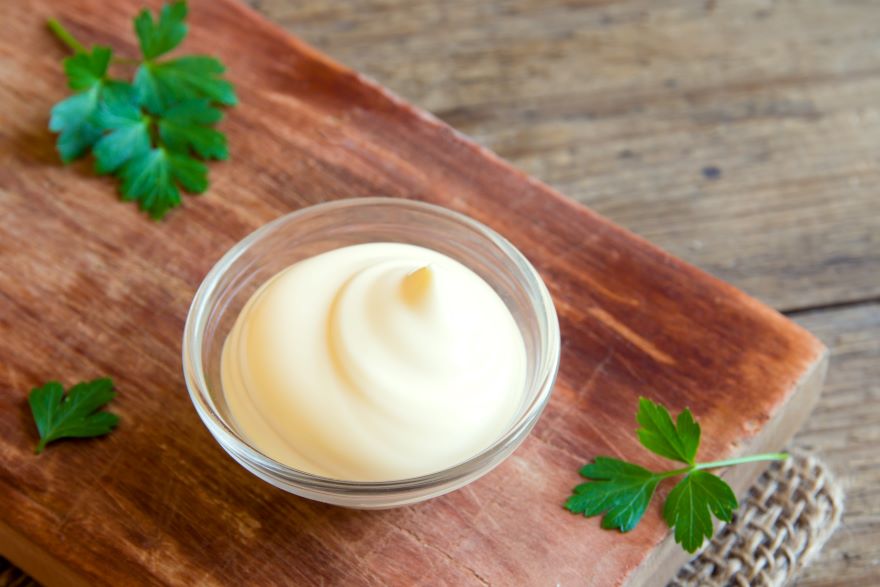While I’m not a huge fan of mayonnaise, I can’t deny its unique taste and texture. Just the other day, I grabbed a bottle of it at the supermarket—why not? It’s incredibly versatile, especially for someone like me who loves salads and sandwiches. But I often find myself wondering, “Is mayo dairy-free?” Understanding the main components of mayonnaise is key, especially since dairy products come from milk. Traditionally, mayonnaise is made with oil, eggs, lemon juice or vinegar, and seasonings—all of which are naturally dairy-free. However, this fact is often overlooked, leading to the common misconception that mayo contains dairy.
The ingredients used in commercially available mayonnaise can slightly vary from brand to brand. Some products might incorporate additives or different types of acid, like lemon juice or various vinegars, which influence flavor and stability. Nevertheless, these variations generally do not affect the dairy-free status of mayonnaise. It’s critical for anyone with dietary restrictions to always check labels carefully, as there can be exceptions. Additionally, I’ve noticed that vegan mayonnaise options have emerged, catering to those avoiding all animal products, including eggs.

Important Insights
One of the most common questions is ‘Is mayo dairy-free?
- Dairy-Free Ingredients: Traditionally, the ingredients used in mayonnaise are dairy-free.
- Label Awareness: Reading labels carefully is necessary since ingredient variations exist among different mayonnaise brands, and some may contain dairy.
- Vegan Options: There are vegan mayonnaise alternatives available for individuals avoiding all animal products.
Decoding Mayonnaise Ingredients
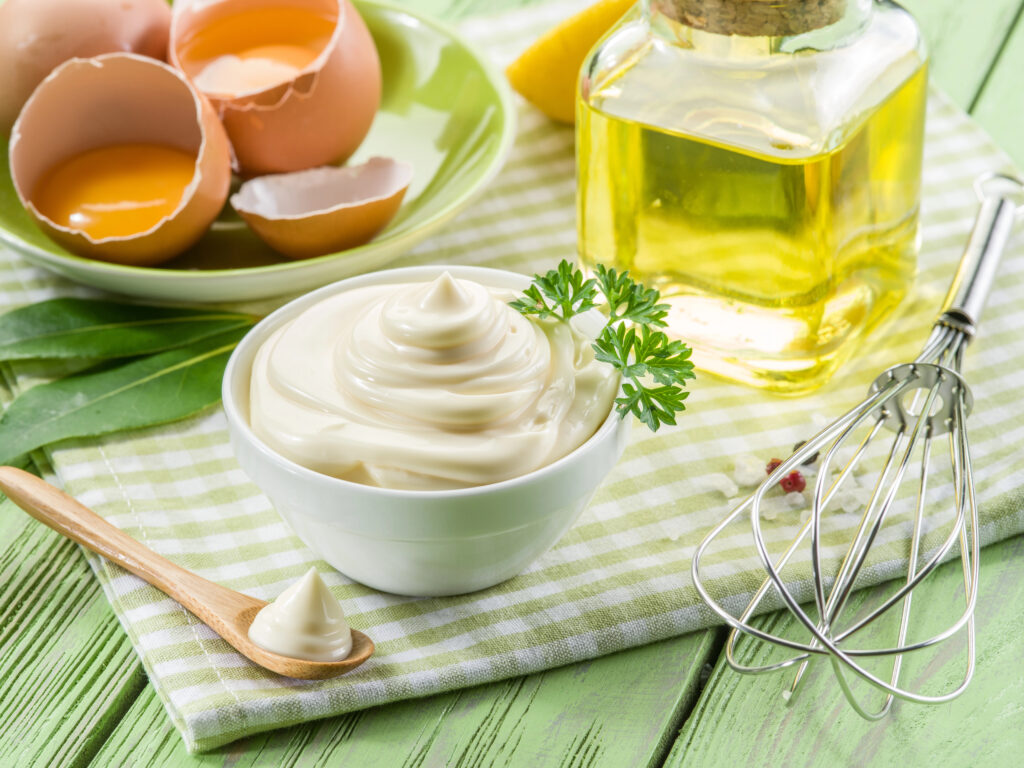
Mayonnaise is a staple in many kitchens, deriving its rich texture and flavor from a blend of simple ingredients. Let’s break down each component to see how they contribute to mayo’s distinctive character.
For those looking to elevate their culinary game, the Breville Sous Chef 12-Cup Food Processor is a top-tier kitchen tool. Perfect for creating homemade mayonnaise with ease, this powerful food processor ensures a smooth, consistent emulsion every time. Its precise controls and versatile functionality make it ideal not only for mayo but also for preparing dressings, sauces, and even dough. With its sleek design and durable construction, this food processor is a worthwhile investment for serious home chefs.
- Grating cheese and chopping herbs or nuts to mixing batters and pureeing soups
- 12 cup cap; BPA Free plastic work bowl; Safety braking system
- Large 5" wide feed chute eliminates need to precut most ingredients
- Momentary pulse button for maximum control and even processing
- 1000 watt induction motor offers great versatility and power in a compact size
Understanding Egg Yolks
Egg yolks act as an emulsifying agent in mayonnaise. Their lecithin content helps oil and water blend together, creating that smooth and stable consistency we all love. I ensure egg yolks are present to achieve the creamy texture that makes mayo so appealing.
The Role of Oil
The choice of oil is critical—it’s what gives mayonnaise its body and acts as the medium for carrying flavors. Using vegetable oils, such as soybean oil, adds lightness and a neutral taste, allowing other ingredients like spices to shine through.
Vinegar’s Function
Vinegar, or sometimes lemon juice, provides the tartness that balances the richness of the oil and egg yolks. It also helps stabilize the emulsion and extends the shelf life of mayonnaise by creating an acidic environment that discourages bacterial growth..
Must-Have Add-ons: Spices and Seasonings
Finally, makers shape the character of mayonnaise by adding spices and seasonings like salt and sugar. These enhance flavor; salt aids in thickening, while sugar brings a subtle sweetness that offsets acidity. Chefs may use spices, such as mustard, to add complexity and depth, while herbs offer a note of freshness. These add-ons are vital in defining the final taste profile of mayonnaise.
By understanding these ingredients, I can appreciate the simple yet complex nature of mayonnaise, confirming it as a non-dairy product suitable for many dietary requirements.
Debunking the Dairy Myth: Is Mayo Dairy-Free?
The creamy, smooth texture of mayonnaise often leads to a common misconception—that it’s a dairy product. This couldn’t be further from the truth. Despite its rich consistency, which might remind you of dairy-based spreads like butter or cream cheese, mayonnaise is completely dairy-free. Its luxurious texture comes from a simple yet ingenious combination of egg yolks, oil, vinegar or lemon juice, and seasonings—none of which are derived from milk or dairy products. Understanding this fundamental difference is crucial, especially for those navigating dietary restrictions or making informed choices about their food. While mayonnaise may share the creamy characteristics of your favorite dairy products, it stands distinctly apart in both composition and classification.
The Truth about Lactose
For individuals who are lactose intolerant or following a dairy-free diet, understanding the distinction between lactose-containing foods and dairy-free options is crucial. Lactose, a sugar found in milk, can trigger digestive issues for some people. While traditional mayonnaise is naturally lactose-free, I’ve made it a habit to meticulously check labels before adding any product to my shopping cart. This practice has become second nature to me, especially since some specialty mayonnaise varieties might contain hidden dairy ingredients for enhanced flavor or texture.
That’s why I always tell my friends and family: a quick label check can save you from unnecessary dietary concerns and allow you to enjoy your mayo worry-free.
Exploring Dairy-Free Variations
In the diverse world of mayonnaise, I’ve noticed that dairy-free options are thriving, catering to both vegan diets and lactose intolerance with plant-based ingredients. Let’s explore these variations.
Going Eggless: Vegan Mayo
Vegan mayonnaise has become a staple for those following a plant-based diet. It replaces eggs with ingredients like aquafaba (the liquid from cooked chickpeas), which mimics emulsification properties quite well. Some producers also incorporate soy protein or modified food starch to achieve the desired consistency and creaminess. I find that vegan mayo often includes additional flavorings, such as garlic or herbs, to enhance taste while maintaining its creamy texture.
Dairy Alternatives in Mayo
While traditional mayonnaise does not contain dairy, some variations might include dairy ingredients for flavor or texture. However, in the realm of dairy-free mayos, manufacturers often use a blend of oils—like avocado or olive oil—to replicate the richness typically provided by dairy without any involvement from animal products.
Evaluating Health Aspects
When evaluating health aspects related to mayonnaise, I think it’s crucial to consider its nutritional content and potential effects on different dietary restrictions.
Nutritional Breakdown
Mayonnaise primarily consists of oil, egg yolks (or alternatives), and vinegar or lemon juice—providing a unique nutritional profile. A tablespoon typically contains about 90 to 100 calories and 10 to 15 grams of fat. I believe consumers should enjoy mayo in moderation within a balanced diet due to its high-fat content. While it is cholesterol-rich due to the egg yolks used in production (approximately 5–10 mg per tablespoon), it remains a suitable condiment option for those who are lactose intolerant.
Health-conscious consumers have become more aware of fat types in their diets lately. Traditional mayonnaise contains unsaturated fats from vegetable oils that can be beneficial when consumed in moderation compared to saturated fats found in some other condiments.
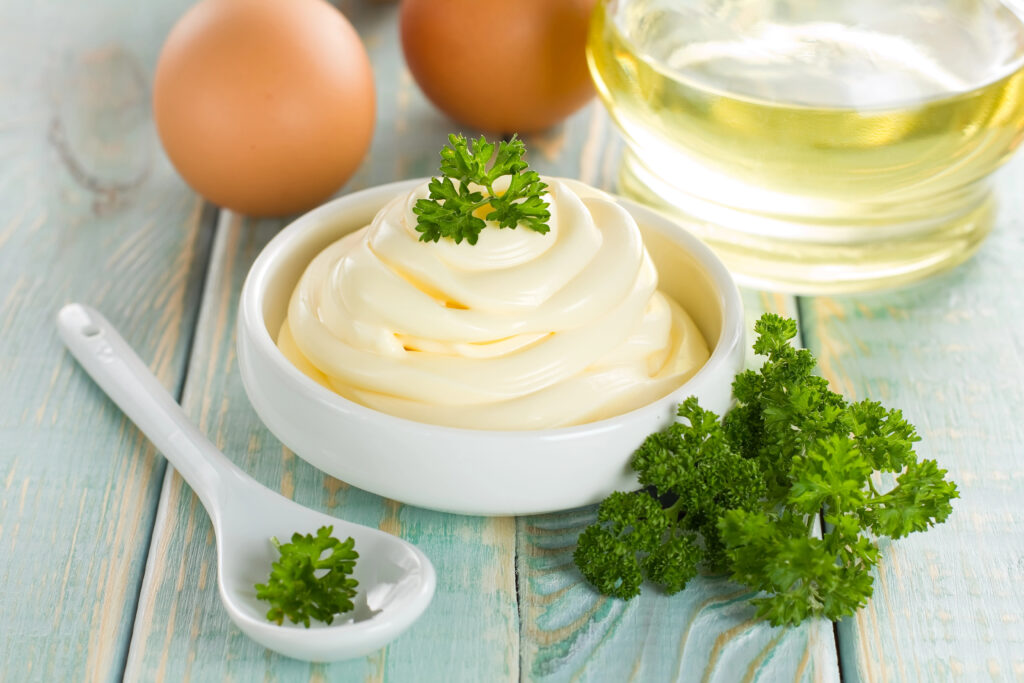
Understanding Allergies and Intolerances
Mayonnaise is gluten-free, making it safe for individuals with celiac disease or gluten sensitivity. For those with egg allergies, many brands offer egg-free versions to meet dietary needs. While mayonnaise is lactose-free due to its lack of milk-based ingredients, I always check labels for potential cross-contamination if I have severe allergies.
In terms of enhancing health benefits, I’ve read that pairing mayonnaise with ingredients containing γ-aminobutyric acid (GABA), produced by certain lactic acid bacteria strains found in fermented foods, could offer calming effects on the body—though traditional mayo does not contain these bacteria.
Comparing Brands and Labels
Among the brands I’ve looked at, the ingredients vary. However, common components include oil, vinegar, and egg yolks (or alternatives). While most traditional mayos do not contain dairy derivatives, some variations might include them. Scrutinizing labels for mentions of milk products is crucial when seeking a dairy-free option.. For instance, certain brands may add casein or whey—milk-based proteins—to their recipes. It’s particularly helpful for me to look for certifications on labels, such as “dairy-free” or “vegan,” to ensure products meet my needs.
I find it best to compare at least a few different labels before making a selection. For example, information available online highlights that while traditional mayo typically doesn’t contain dairy, checking labels is always a good habit.
When looking for a delicious and healthy dairy-free option, I highly recommend Sir Kensington’s Avocado Oil Mayonnaise. Made with avocado oil, this mayo is not only dairy-free but also non-GMO and gluten-free while being Keto- and Paleo-certified. Its creamy texture makes it an excellent choice for sandwiches, dips, salads—or even dressings!
- Sir Kensington's Avocado Oil Mayonnaise is made with the highest quality, non-GMO ingredients like 100% avocado oil.
- Avocado Oil Mayo is a real mayonnaise made with a squeeze of lime and a pinch of black pepper.
- This Avocado Oil Mayo is Paleo and Keto Diet Certified condiment, containing no sugar. And, it is shelf-stable.
- All Sir Kensington's condiments and dressings are proudly gluten free.
- We don't use artificial ingredients, colors or preservatives in our Avocado Oil Mayonnaise
Homemade vs. Store-Bought
Making homemade mayo gives me control over what goes into my mixture. The basic ingredients include oil (such as olive or avocado), egg yolks (or aquafaba for vegan versions), and lemon juice or vinegar—all natural dairy-free!
To make homemade mayo:
- Combine 1 large egg yolk (or 3 tablespoons aquafaba) with 1 tablespoon mustard (optional) in a bowl.
- Slowly drizzle in about 1 cup of oil while whisking vigorously until emulsified.
- Add 1 tablespoon lemon juice or vinegar along with salt to taste.
- Adjust flavors by adding herbs or spices as desired.
- Store in an airtight container in the fridge for up to one week.
On the other hand, store-bought mayonnaise offers convenience with consistent flavor; however, vigilance is key due to potential ingredient variations across different products.
Classic Recipes Using Mayonnaise
I often use mayonnaise as a base for multiple dressings and sauces that transform dish flavors significantly. Classic recipes include:
- Egg Salad: where mayo binds ingredients together
- Potato Salad: providing a rich creamy dressing
- Coleslaw: where shredded cabbage combines with mayo-based dressing
Here are three delicious recipes that showcase the versatility of mayonnaise:
Classic Tuna Salad with Fresh Herbs
- 2 cans of chunk light tuna, drained
- 1/3 cup mayonnaise
- 1/4 cup finely diced celery
- 2 tablespoons minced red onion
- 1 tablespoon fresh dill, chopped
- 1 tablespoon fresh parsley, chopped
- 1 teaspoon lemon juice
- Salt and pepper to taste
Instructions:
- In a medium bowl, combine the drained tuna, mayonnaise, celery, red onion, dill, parsley, and lemon juice.
- Mix well until all ingredients are evenly incorporated.
- Season with salt and pepper to taste.
- Chill for at least 30 minutes before serving to allow the flavors to meld.
- Serve as a sandwich filling, on crackers, or over a bed of mixed greens.
Creamy Herb Aioli
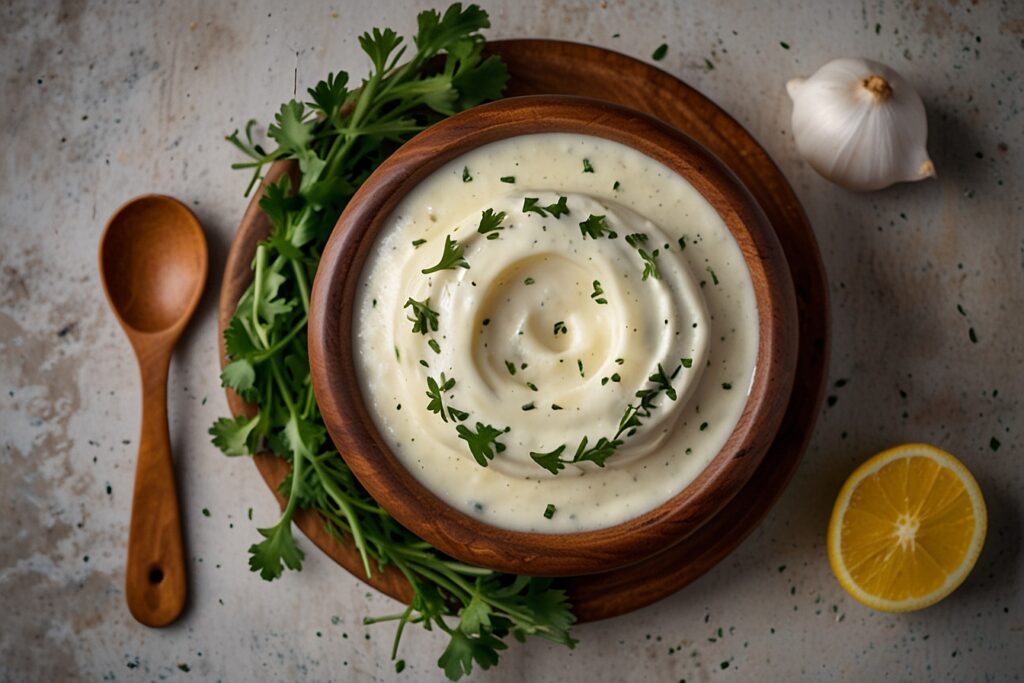
- 1 cup mayonnaise
- 3 cloves garlic, minced
- 2 tablespoons fresh lemon juice
- 1/4 cup mixed fresh herbs (basil, parsley, chives)
- Salt and pepper to taste
Instructions:
- Combine the mayonnaise, minced garlic, lemon juice, and fresh herbs in a food processor.
- Blend until smooth.
- Season with salt and pepper to taste.
- Transfer to a bowl, cover, and refrigerate for at least 1 hour to allow the flavors to meld.
Serving Suggestions:
This versatile aioli works wonderfully as a dip for crudités, a spread for sandwiches, or an accompaniment to roasted vegetables.
Spicy Chipotle Mayo
- 1 cup mayonnaise
- 2-3 chipotle peppers in adobo sauce (adjust to taste)
- 1 tablespoon lime juice
- 1/4 teaspoon garlic powder
- Pinch of salt
Instructions:
- Place the mayonnaise, chipotle peppers, lime juice, garlic powder, and salt in a blender or food processor.
- Blend until smooth and creamy.
- Taste and adjust the heat level by adding more chipotle peppers if desired.
Serving Suggestions:
This smoky, spicy mayo is perfect for spreading on sandwiches, drizzling over tacos, or serving as a dipping sauce for fries or onion rings.
Innovative Applications of Mayonnaise
Beyond traditional uses, mayonnaise shines in creative and unexpected ways:
- Dips and Spreads: Garlic-infused mayo elevates simple crudités, while dill-infused mayo adds complexity to sandwiches.
- Baking: Incorporating mayo into cake batter results in moist, tender cakes due to its fat content.
- Marinades: Use mayo as a base for marinades—it locks in moisture and enhances flavor while grilling chicken or seafood.
- Salad Dressings: Combine mayo with yogurt or sour cream for creamy dressings ideal for fresh greens.
The Le Creuset Signature Enameled Cast Iron Saucepan is a luxury addition to any kitchen. Its even heat distribution and elegant design make it perfect for heating or whisking delicate sauces, like aioli or other mayonnaise-based creations. Whether you’re preparing a warm hollandaise or experimenting with infused mayos, this premium saucepan delivers professional results with ease. Its vibrant enamel coating adds a touch of sophistication to your cookware collection while ensuring long-lasting durability.
- Enameled cast iron delivers superior heat distribution and retention
- Ready to use, requires no seasoning
- Easy-to-clean and durable enamel resists dulling, staining, chipping and cracking
- Light colored smooth interior enamel allows easy monitoring of cooking progress
- Tight-fitting lids are specially designed to circulate steam and return moisture back to the food
Cultural Inspirations
Mayonnaise is not only a staple in Western kitchens but also plays a significant role in diverse culinary traditions around the world.
- In Japanese cuisine, Kewpie mayonnaise is a beloved ingredient, known for its tangy sweetness. This unique version uses rice vinegar instead of the distilled vinegar commonly found in traditional mayonnaise, making it ideal for sushi rolls and other dishes.
- In French cuisine, aioli is a classic garlic-infused sauce made with mayonnaise as a base. It’s especially popular in Provence, where it’s served alongside seafood dishes like bouillabaisse.
These examples highlight the global versatility of mayonnaise, showing how it transcends cultures while remaining true to its core as a dairy-free condiment.

Bridging Traditions
As I write this article, I couldn’t help but get fascinated by how a simple emulsion has evolved into countless cultural interpretations. From the tangy sweetness of Japanese Kewpie that elevates my sushi rolls, to the rich garlic notes of French aioli that transforms my seafood dishes – each variation tells a unique story. What amazes me most is how this dairy-free condiment has seamlessly woven itself into diverse culinary traditions, creating a tapestry of flavors that transcends dietary restrictions and cultural boundaries. As we wrap up our exploration of this beloved condiment, let’s reflect on what we’ve learned about its dairy-free nature
Final Thoughts
Is mayo dairy-free? The answer is yes—traditional mayonnaise is indeed dairy-free. The core ingredients of mayonnaise—oil, eggs (or egg alternatives), vinegar or lemon juice, and seasonings—contain no milk or milk-based products. Because mayonnaise is made through an emulsification process that doesn’t involve dairy, it is naturally free from lactose, which is the sugar found in milk that can cause digestive issues for those who are lactose intolerant. For individuals with dietary restrictions, this makes mayonnaise a safe and versatile condiment option, as long as it doesn’t include any added dairy products in variations like flavored mayos or specialty brands.
Understanding these components allows me—and others with dietary restrictions—to confidently incorporate mayo into meals. It’s important to check labels, though, as some brands may add dairy ingredients such as casein or whey, which are derived from milk. If you’re unsure, always opt for products labeled “dairy-free.”
In our culinary journey, it’s important to remember that we don’t have to deprive ourselves of the foods we love. If a certain dish doesn’t align with our dietary needs, there are always alternatives that can offer the same great taste without compromising our health. The key is moderation and balance. Enjoying food that nourishes our bodies and pleases our taste buds doesn’t mean we have to sacrifice flavor or variety. So, embrace the opportunity to experiment with new flavors and make choices that work best for your body—there’s always room for deliciousness without guilt!
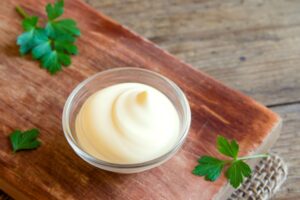
*We may earn a commission for purchases made using our links. Please see our disclosure to learn more.

